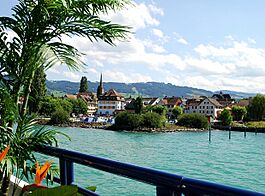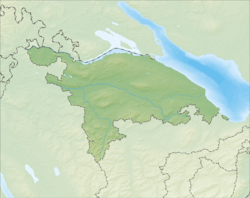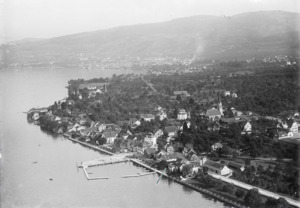Horn, Switzerland facts for kids
Quick facts for kids
Horn
|
||
|---|---|---|

Horn village
|
||
|
||
| Country | Switzerland | |
| Canton | Thurgau | |
| District | Arbon | |
| Area | ||
| • Total | 1.73 km2 (0.67 sq mi) | |
| Elevation | 402 m (1,319 ft) | |
| Population
(Dec 2020 )
|
||
| • Total | 2,888 | |
| • Density | 1,669/km2 (4,324/sq mi) | |
| Postal code |
9326
|
|
| Surrounded by | Goldach (SG), Tübach (SG), Steinach (SG), Lake Constance | |
Horn is a small town, also called a municipality, in Switzerland. It's located in the canton of Thurgau. Horn is special because it's an exclave, meaning it's a part of Thurgau that is completely surrounded by the canton of St. Gallen.
Contents
History of Horn
Horn was first mentioned in old writings in 1155. Back then, it was called Horna. A special farm called the Kehlhof was built in Horn in the 800s. It was probably for the Diocese of Constance, which was a church area.
In 1463, the Bishop of Constance took control of the whole area of Horn. Until 1798, Horn was under the court in Arbon. The Bishop made important decisions and laws for the area.
The town's official borders and local government were set up in 1816. Later, in 1870, these two parts joined to become one municipality.
Horn used to be part of the main church area, or parish, of Arbon. In 1877, a shared chapel was built. This meant both Catholics and Protestants could use it. Later, in 1911, the Catholic church in Horn became its own parish. The Reformed church followed in 1920.
In the 1800s, people in Horn mainly worked in fishing, weaving, and making things by hand. In 1824, a steamship company started regular trips. This helped the local economy grow. Horn was even known as a spa and health resort called Bad Horn.
Towards the end of the 1800s, farming became more popular. People started raising cattle, producing dairy, and growing fruit. After the SBB train line opened in 1869, more factories came to Horn. These included a bleaching company (Radun AG, 1888) and an oil and fat factory (Sais, 1916–17).
By 1920, factories and industries became more important than farming. Radun AG closed in 1989, and the oil factory closed in 2000. However, some companies like Unisto AG (which makes security seals) and Sabo Specialities (from the old Sais factory) still provide jobs in manufacturing today.
Geography of Horn
Horn covers an area of about 1.72 square kilometers (0.66 square miles). A big part of this land, about 41.3%, is used for farming. Forests cover about 8.7% of the area.
About half of Horn's land, 50%, is developed with buildings or roads. A small part, 0.6%, is made up of rivers or lakes. The rest, also 0.6%, is land that isn't used for anything.
The town of Horn is located in the Arbon district. It sits right on the beautiful Lake Constance, between the towns of Arbon and Rorschach.
People of Horn
Horn has a population of about 2,429 people. As of 2008, about 16.3% of the people living in Horn were from other countries. Over ten years, from 1997 to 2007, the number of people living in Horn grew by 2%.
Most people in Horn (90.1%) speak German. Italian is the second most common language (2.7%), followed by Portuguese (1.5%).
In 2008, there were slightly more men (50.2%) than women (49.8%) living in Horn. The population grew by 4.8% in 2008.
Here's how the ages of people in Horn were spread out in 2009:
- Children (0-9 years old): 9.1%
- Teenagers (10-19 years old): 11.0%
- Young adults (20-29 years old): 11.1%
- Adults (30-39 years old): 13.7%
- Adults (40-49 years old): 17.2%
- Adults (50-59 years old): 13.8%
- Seniors (60-69 years old): 11.1%
- Seniors (70-79 years old): 7.2%
- Seniors (80-89 years old): 4.9%
- Seniors (90 and older): 0.9%
In 2000, there were 1,057 homes in Horn, with about 2.2 people living in each home. Most homes were single-family houses (59%). Many people lived in couples with children (47.7%).
The average rent for an apartment in Horn in 2000 was about 1056 Swiss francs per month. This was a bit less than the average rent across Switzerland.
Here's how the population of Horn has changed over time:
| year | population |
|---|---|
| 1850 | 403 |
| 1900 | 700 |
| 1950 | 1,288 |
| 1980 | 1,909 |
| 1990 | 2,218 |
| 2000 | 2,421 |
Economy of Horn
In 2007, Horn had a low unemployment rate of 1.64%. This means most people who wanted jobs had them.
In 2005, about 22 people worked in the primary sector. This includes jobs like farming or fishing. There were 8 businesses in this area.
About 350 people worked in the secondary sector. This means jobs in factories or making things. There were 28 businesses in this sector.
The largest number of people, 684, worked in the tertiary sector. These are jobs that provide services, like shops, offices, or healthcare. There were 98 businesses in this sector.
In 2000, many people who lived in Horn worked outside the town (54%). However, many people also came into Horn to work. About 8.2% of workers used public transport, and 51.6% drove their own cars to work.
Religion in Horn
Based on the 2000 census, people in Horn follow different religions:
- About 48.0% were Roman Catholic.
- About 34.0% belonged to the Swiss Reformed Church (Protestant).
- A small number (1.32%) were part of the Orthodox Church.
- About 1.49% belonged to other Christian churches.
- About 2.68% were Islamic.
- Some people (8.72%) said they had no religion, or were agnostic (not sure about God) or atheist (don't believe in God).
Education in Horn
Switzerland is known for its good education system. In Horn, about 77.6% of adults (aged 25-64) have finished high school or gone on to higher education, like university.
Horn has its own school district for primary and secondary schools. In the 2008/2009 school year, there were 193 students.
- Kindergarten: There were 43 children in kindergarten. The average class had about 21-22 kids. About half of the kindergarteners were girls. A small number were not Swiss citizens or did not speak German as their first language.
- Primary School: This level starts around age 5-6 and lasts for 6 years. There were 67 children in lower primary and 83 in upper primary. The average class size was about 18-19 students.
- Secondary School: This level starts around age 12 and usually lasts 3 years. Students are grouped based on how well they learn. In Horn, 76 teenagers were in classes that offered extra support or different learning methods.
See also
 In Spanish: Horn (Turgovia) para niños
In Spanish: Horn (Turgovia) para niños





